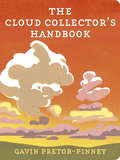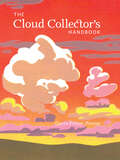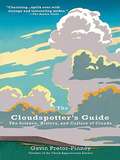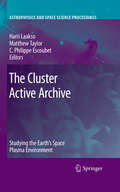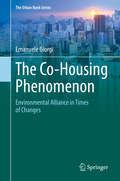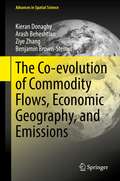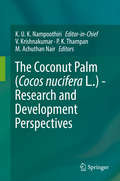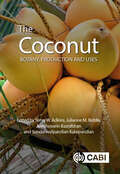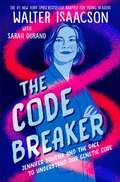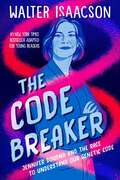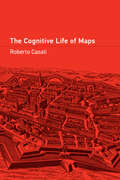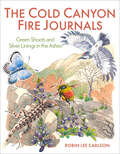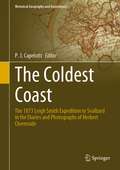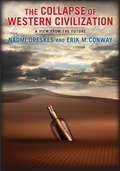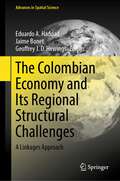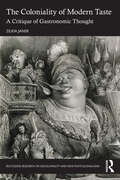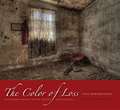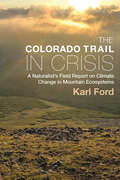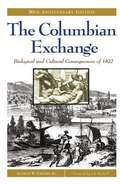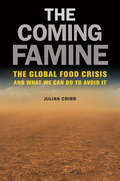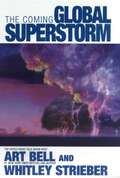- Table View
- List View
The Cloud Collector's Handbook
by Gavin Pretor-PinneyTHE CLOUD COLLECTOR'S HANDBOOK fits into pockets, allowing cloudspotters to identify cloud formations anytime and anywhere. All the common cloud types are represented, as are many of the rare ones, each fully described and illustrated with a range of photographs. Not only is THE CLOUD COLLECTOR'S HANDBOOK an invaluable resource for anyone who wants to be able to identify and understand every cloud that floats by, it also caters for the competitive cloudspotter. Points are awarded for each cloud type identified - the rarer the cloud, the greater points - and there's space to fill in where and when it was sighted.Beautifully designed, in colour throughout, and full of the humour that made THE CLOUDSPOTTER'S GUIDE so engaging, the HANDBOOK is the essential reference for anyone with their head in the clouds.
The Cloud Collector's Handbook
by Gavin Pretor-PinneyKeep your head in the clouds with this whimsical guide to the wonders of the sky from an award-winning science writer.In The Cloud Collector’s Handbook, cloud expert Gavin Pretor-Pinney catalogs a variety of clouds and gives readers points for spotting them and recording their finds. This fun and fact-filled book features gorgeous full-color photographs that showcase various types of clouds, from fluffy cumulus to the super rare horseshoe vortex to the wispy noctilucent clouds that hang at the fringes of space.Sure to be a hit with both aspiring and seasoned cloud gazers, this clever handbook comes from the bestselling author, BBC presenter, and founder of the Cloud Appreciation Society.
The Cloudspotter's Guide
by Gavin Pretor-Pinney'The clouds are nature's poetry, and the most egalitarian of her displays, since everyone has an equally fantastic view of them. Clouds are for dreamers, and their contemplation benefits the soul. Yet their beauty is so everyday as to be in danger of being overlooked . . . ' Gavin Pretor Pinney is the chairman and founder member of the Cloud Appreciation Society. He contends that we are blessed in this country with a uniquely rich and varied cloudscape, which has hitherto been sadly undervalued. His book teaches us to appreciate their different varieties - the cumulus, nimbostratus and Morning Glory to name only a few - and all their beauties and significances, both meteorological and cultural. We learn how Hindus believed the cumulus clouds were the spiritual cousins of elephants, how thermal air currents act on fair weather cumuli, and how to save a fortune in psychiatric bills by using the clouds as Rorschach images that reflect our state of mind as well as nature's moods. Looking up will never be the same again.
The Cloudspotter's Guide
by Gavin Pretor-PinneyNow in paperback: the runaway British bestseller that has cloudspotters everywhere looking up. Where do clouds come from? Why do they look the way they do? And why have they captured the imagination of timeless artists, Romantic poets, and every kid who's ever held a crayon? Veteran journalist and lifelong sky watcher Gavin Pretor-Pinney reveals everything there is to know about clouds, from history and science to art and pop culture. Cumulus, nimbostratus, and the dramatic and surfable Morning Glory cloud are just a few of the varieties explored in this smart, witty, and eclectic tour through the skies. Illustrated with striking photographs (including a new section in full-color) and line drawings featuring everything from classical paintings to lava lamps, The Cloudspotter's Guide will have enthusiasts, weather watchers, and the just plain curious floating on cloud nine.
The Cluster Active Archive
by Matthew Taylor C. Philippe Escoubet Harri LaaksoSince the year 2000 the ESA Cluster mission has been investigating the small-scale structures and processes of the Earth's plasma environment, such as those involved in the interaction between the solar wind and the magnetospheric plasma, in global magnetotail dynamics, in cross-tail currents, and in the formation and dynamics of the neutral line and of plasmoids. This book contains presentations made at the 15th Cluster workshop held in March 2008. It also presents several articles about the Cluster Active Archive and its datasets, a few overview papers on the Cluster mission, and articles reporting on scientific findings on the solar wind, the magnetosheath, the magnetopause and the magnetotail.
The Co-Housing Phenomenon: Environmental Alliance in Times of Changes (The Urban Book Series)
by Emanuele GiorgiThis book presents 50 case studies of contemporary co-housing projects spread all over the world to show how communities of shared living have become a global phenomenon that can serve as a tool to promote social and urban sustainability. By presenting evidence that shared housing experiences are capable of revitalizing sterile urban fabrics and promoting social sustainable practices, the volume situates co-housing experiences as microscale responses to the macroscale challenges posed by environmental degradation and the decline of communitarian ways of living.The volume also reviews the most famous typologies of shared living in different parts of the world across human history. By analyzing historical experiences in different regions of Africa, Americas, Asia, Europe and Oceania, the author shows that living together is part of a historical culture of sharing that is being rediscovered all over the world by people who activate public spaces, work in shared offices or live in contractual communities. The Co-Housing Phenomenon – Environmental Alliance in Times of Changes will be of interest to both professionals and scholars involved in urban design, urban planning and architecture, especially those in the field of sustainable urbanism. It will also be a valuable resource for public agents and civil society organizations dealing with housing, social, environmental and sustainability policies.
The Co-evolution of Commodity Flows, Economic Geography, and Emissions (Advances in Spatial Science)
by Kieran Donaghy Arash Beheshtian Ziye Zhang Benjamin Brown-SteinerThis book presents extensions to current commodity-flow models to analyze the economic and environmental impacts of recent structural changes, such as fragmentation of production and lengthening supply chains. The extensions enable augmented commodity-flow models to analyze the vulnerability of supply chains and regions to climate change and extreme weather events. The models allow the explicit treatment of trade in intermediate goods; the so-called “new economic geography” behavioral foundations for production and inter-industry and interregional trade; endogenous determination of capital investment and employment; and changes in emissions associated with production, consumption and freight movement. Presenting a modeling framework and simulations that are based on a thirty-year, spatial time-series of inter-industry and interstate trade in the US, this unique book is a valuable resource for regional scientists, economic geographers and transportation modelers, as well as environmental and atmospheric scientists.
The Coconut Palm (Cocos nucifera L.) - Research and Development Perspectives
by K. U. Nampoothiri V. Krishnakumar P. K. Thampan M. Achuthan NairSince the publication of "The coconut palm - A monograph" in 1960, considerable information has been accrued on the crop through work at research institutes, international organisations and development agencies. Although coconut cultivation is spread over 93 countries, providing employment and creating livelihood opportunities to 64 million families around the globe, smallholder coconut farmers are now facing numerous challenges. The wide gap between the potential and actual yield is a major concern, and as such it is necessary to disseminate knowledge in order to implement research findings. Coconut research in India, one of the leading coconut producing countries, is celebrating its centenary, making this an opportune time to review the research and development advances and the relevant technologies. This detailed, comprehensive book covers all aspects of coconut, from the origins to cultivation, breeding, physiology and value addition, as well as subjects of topical interest like nutrition and health, biotechnology, and climate change and carbon sequestration. Written by leading experts in the fields it emphasises that the livelihood of the small coconut landholders is the ultimate aim of scientists and developmental agencies, and outlines various important strategies to make coconut farming more remunerative globally. It discusses work in all the major coconut growing countries and outlines suggestions for international cooperation.Research work on the crop is comparatively difficult because of its perennial nature, longevity, height, long juvenile phase, large sized nuts, cross pollination and seed propagation. As these special features necessitate greater investment of resources, time and land, it is all the more imperative that research is not duplicated and the information and experience becoming available around the world is shared so that it can be fully utilised. In this context periodic publications, compiling all the available information on coconut assume greater significance. This book is therefore of great value to researchers, students, extension workers, developmental agencies and progressive farmers.
The Coconut: Botany, Production and Uses (Botany, Production and Uses)
by K. Chapman Q. T. Nguyen S. Rajkumar C. Yang R. Cave S. V. Ramesh C. Oropeza E. A. Aguilar J. Alouw F. C. Beveridge M. A. Bezerra R. Bhat R. Dakshayani F. M. Dayrit P. D. Dissanayake H. R. Gheyi K. B. Hebbar V. B. Johnson Sundaravelpandian Kalaipandian S. Karouw A. C. Khanashyam E.Y.Y. Kong C.F.D. Lacerda J. C. Lacsina M. R. Manikantan E. C. Manohar Z. Mu M. Narváez M. F. Neto C. F. Ortiz R. Pandiselvam B. Panis A. Peña L. Perera S. Periasamy M. Ramaswamy E. Ramos N. Satyaseelan C. Silverio S. Sisunandar P. Subramanian P. A. Sukumar R. S. Veluchamy V.R.M. Vidhanaarachchi H. WilmsThe coconut palm (Cocos nucifera L.) is one of the world's most important palms, and contributes significantly to the income and livelihood of many people in tropical countries. Widely referred to as the 'tree of life', coconut has been used as a source of food, drink, oil, medicine, shelter and wood for around 500 years. Every part of the coconut palm can be utilized. The demand for coconut fruit and its products has increased recently as people have become aware of its nutritional and health benefits, especially those of coconut water and virgin coconut oil. This book covers all aspects of coconut including origins and diversity; ecophysiology; production in a changing climate; pests and diseases; harvest and postharvest management; breeding and genetics; as well as the current and future status of coconut as an economic crop. This book is a key resource for researchers and students in horticulture, plant science and agriculture, and those interested in the production of tropical crops, and practitioners in the coconut industry.
The Code Breaker -- Young Readers Edition: Jennifer Doudna and the Race to Understand Our Genetic Code
by Walter IsaacsonWalter Isaacson&’s #1 New York Times bestselling history of our third scientific revolution: CRISPR, gene editing, and the quest to understand the code of life itself, is now adapted for young readers!When Jennifer Doudna was a sixth grader in Hilo, Hawaii, she came home from school one afternoon and found a book on her bed. It was The Double Helix, James Watson&’s account of how he and Francis Crick had discovered the structure of DNA, the spiral-staircase molecule that carries the genetic instruction code for all forms of life. This book guided Jennifer Doudna to focus her studies not on DNA, but on what seemed to take a backseat in biochemistry: figuring out the structure of RNA, a closely related molecule that enables the genetic instructions coded in DNA to express themselves. Doudna became an expert in determining the shapes and structures of these RNA molecules—an expertise that led her to develop a revolutionary new technique that could edit human genes. Today gene-editing technologies such as CRISPR are already being used to eliminate simple genetic defects that cause disorders such as Tay-Sachs and sickle cell anemia. For now, however, Jennifer and her team are being deployed against our most immediate threat—the coronavirus—and you have just been given a front row seat to that war.
The Code Breaker -- Young Readers Edition: Jennifer Doudna and the Race to Understand Our Genetic Code
by Walter IsaacsonWalter Isaacson&’s #1 New York Times bestselling history of our third scientific revolution: CRISPR, gene editing, and the quest to understand the code of life itself, is now adapted for young readers! When Jennifer Doudna was a sixth grader in Hilo, Hawaii, she came home from school one afternoon and found a book on her bed. It was The Double Helix, James Watson&’s account of how he and Francis Crick had discovered the structure of DNA, the spiral-staircase molecule that carries the genetic instruction code for all forms of life. This book guided Jennifer Doudna to focus her studies not on DNA, but on what seemed to take a backseat in biochemistry: figuring out the structure of RNA, a closely related molecule that enables the genetic instructions coded in DNA to express themselves. Doudna became an expert in determining the shapes and structures of these RNA molecules —an expertise that led her to develop a revolutionary new technique that could edit human genes. Today gene-editing technologies such as CRISPR are already being used to eliminate simple genetic defects that cause disorders such as Tay-Sachs and sickle cell anemia. For now, however, Jennifer and her team are being deployed against our most immediate threat—the coronavirus—and you have just been given a front row seat to that war.
The Cognitive Life of Maps
by Roberto CasatiThe &“mapness of maps&”—how maps live in interaction with their users, and what this tells us about what they are and how they work.In a sense, maps are temporarily alive for those who design, draw, and use them. They have, for the moment, a cognitive life. To grapple with what this means—to ask how maps can be alive, and what kind of life they have—is to explore the core question of what maps are. And this is what Roberto Casati does in The Cognitive Life of Maps, in the process assembling the conceptual tools for understanding why maps have the power they have, why they are so widely used, and how we use (and misuse) them.Drawing on insights from cognitive science and philosophy of mind, Casati considers the main claims around what maps are and how they work—their specific syntax, peculiar semantics, and pragmatics. He proposes a series of steps that can lead to a precise theory of maps, one that reveals what maps have in common with diagrams, pictures, and texts, and what makes them different. This minimal theory of maps helps us to see maps nested in many cognitive artifacts—clock faces, musical notation, writing, calendars, and numerical series, for instance. It also allows us to tackle the issue of the territorialization of maps—to show how maps can be used to draw specific spatial inferences about territories. From the mechanics of maps used for navigation to the differences and similarities between maps and pictures and models, Casati's ambitious work is a cognitive map in its own right, charting the way to a new understanding of what maps mean.
The Cold Canyon Fire Journals: Green Shoots and Silver Linings in the Ashes
by Robin Lee CarlsonBraiding together illustration, observation, and reportage, artist and naturalist Robin Lee Carlson offers a watershed work that will forever change how we live with wildfire in the WestWhen the nature reserve at Cold Canyon went up in flames—a casualty of California’s raging fire seasons—Robin Lee Carlson embarked on a five-year journey to learn the legacy of the burn. Spurred by scientific curiosity, Carlson’s deep digs into the natural history of this fire-swept ecosystem unearth mind-bending revelations about nature’s wild wisdom. Her transformative story of fire as a force for renewal underscores what scientists are urgently working to understand: that in California’s wildfire ecologies, fire functions as an elemental power that does not destroy the diverse habitats of California, but regenerates them. Richly illustrated in pen, ink, and watercolor, this snapshot of Cold Canyon’s wildlife emerging from the ashes introduces the reader to the wonder of ecological kinship and its cycles in our wild lands. Carlson’s artistic and scientific journey ultimately leads her (and us) to a new understanding of how we must live in relationship to fire and to the land. With fire suppression and climate change undermining the essential regenerative work of fire in our ecosystem, Carlson’s story is an urgent one—one that shows us how cultivating intimacy with our natural world teaches us what we need to do to sustain it.
The Coldest Coast: The 1873 Leigh Smith Expedition to Svalbard in the Diaries and Photographs of Herbert Chermside (Historical Geography and Geosciences)
by Grenna MuseumThis book describes the 1873 voyage of the British explorer Benjamin Leigh Smith, based on the diaries and photographs of Lieutenant Herbert C. Chermside, who joined the expedition of the seas around Svalbard. Chermside’s photographs, long believed lost, have recently been uncovered in Sweden and are being curated there by the Grenna Museum. The three unpublished diaries of Herbert Chermside were lent to the Scott Polar Research Institute in 1939 by Mrs. Benjamin Leigh Smith. For the first time, Chermside’s diaries are published in their entirety, with the original photographs shown alongside modern images of the same locations. This includes the first photographic record of the north coast of Svalbard, images that are today being used as comparative data for the study of climate change in the archipelago.The diaries have been fully transcribed and edited. Introductory chapters are included, written by specialists in the history of exploration, history of science, and the history of photography from Penn State University, the University of Gothenburg, and UiT, the Arctic University of Norway, as well as contributors from the UK and Germany.This volume is published in association with Grenna Museum, which will present Chermside’s photographs in a 2022 exhibit on Leigh Smith and A.E. Nordenskiold.
The Collaboratory: A Co-creative Stakeholder Engagement Process for Solving Complex Problems
by Adam Kahane John North Paul Shrivastava Zaid Hassan Stephen Hickman Peter Hayward Ronald Fry Philip Mirvis Eddie Blass Claire Maxwell Katrin Muff Aaron Williamson Anders Aspling Anthony Buono Bill Burck Caroline Rennie Gregoire Serikoff Jackie Bagnall Janette Blainey Jonas Haertle Louie Gardiner Mark Drewell Otto Scharmer Patrick Frick Svenja Rüger Thomas DyllickThe introduction is free to download here.This book is about empowering ordinary people to make a difference in the world. It explores the transformation that emerges when groups spread around the world working on similar issues discover synchronicities, often cross-pollinating, and collaborate rather than compete. A Collaboratory is a facilitated space where stakeholders meet to discuss burning societal issues. Each collaboratory is different and needs to be carefully designed to fit the context, ambition, purpose, stakeholders, culture, and space.Part 1 of the book sets the stage by explaining what a collaboratory is, where it emerges from, how it is defined and how it fits into the larger context of the social lab revolution that is happening all over the world.Part 2 of the book unpacks the many dimensions and considerations that contribute to the magic of a collaboratory experience. We offer nine unique insights and perspectives that need to be considered and form an integral part of a successful collaboratory.Part 3 offers eight inspiring examples of how a collaboratory could be applied. We look at applications in the educational field, within organizations, among institutions, and as movements.Part 4 offers a pragmatic outlook on how to get started if you want to use the Collaboratory in your own field of work. The book offers a narrative roadmap using a real-life example of a co-designed and co-created Collaboratory in Norway.Offering practical recommendations and benefits, and bringing together insights from a range of experienced academics, practitioners and facilitators, The Collaboratory is a handbook for experienced or aspiring practitioners in all fields of change: in society, in organizations of all kind and in the field of education.
The Collapse of Western Civilization
by Naomi Oreskes Erik M. ConwayThe year is 2393, and a senior scholar of the Second People's Republic of China presents a gripping and deeply disturbing account of how the children of the Enlightenment, the political and economic elites of the so-called advanced industrial societies, entered into a Penumbral period in the early decades of the twenty-first century, a time when sound science and rational discourse about global change were prohibited and clear warnings of climate catastrophe were ignored. <P><P>What ensues when soaring temperatures, rising sea levels, drought, and mass migrations disrupt the global governmental and economic regimes? <P><P>The Great Collapse of 2093.This work is an important title that will change how readers look at the world. Dramatizing climate change in ways traditional nonfiction cannot, this inventive, at times humorous work reasserts the importance of scientists and the work they do and reveals the self-serving interests of the so called "carbon industrial complex" that have turned the practice of sound science into political fodder. <P><P>The authors conclude with a critique of the philosophical frameworks, most notably neo-liberalism, that do their part to hasten civilization's demise. <P><P>Based on sound scholarship yet unafraid to tilt at sacred cows in both science and policy, this book provides a welcome moment of clarity amid the cacophony of climate change literature. It includes a lexicon of historical and scientific terms that enriches the narrative and an interview with the authors.
The Collapse of Western Civilization: A View from the Future
by Naomi Oreskes Erik ConwayThe year is 2393, and the world is almost unrecognizable. Clear warnings of climate catastrophe went ignored for decades, leading to soaring temperatures, rising sea levels, widespread drought and—finally—the disaster now known as the Great Collapse of 2093, when the disintegration of the West Antarctica Ice Sheet led to mass migration and a complete reshuffling of the global order. Writing from the Second People's Republic of China on the 300th anniversary of the Great Collapse, a senior scholar presents a gripping and deeply disturbing account of how the children of the Enlightenment—the political and economic elites of the so-called advanced industrial societies—failed to act, and so brought about the collapse of Western civilization. In this haunting, provocative work of science-based fiction, Naomi Oreskes and Eric M. Conway imagine a world devastated by climate change. Dramatizing the science in ways traditional nonfiction cannot, the book reasserts the importance of scientists and the work they do and reveals the self-serving interests of the so called "carbon combustion complex" that have turned the practice of science into political fodder. Based on sound scholarship and yet unafraid to speak boldly, this book provides a welcome moment of clarity amid the cacophony of climate change literature.
The Collapse of the Eastern Mediterranean
by Ronnie EllenblumAs a 'Medieval Warm Period' prevailed in Western Europe during the tenth and eleventh centuries, the eastern Mediterranean region, from the Nile to the Oxus, was suffering from a series of climatic disasters which led to the decline of some of the most important civilisations and cultural centres of the time. This provocative study argues that many well-documented but apparently disparate events – such as recurrent drought and famine in Egypt, mass migrations in the steppes of central Asia, and the decline in population in urban centres such as Baghdad and Constantinople – are connected and should be understood within the broad context of climate change. Drawing on a wealth of textual and archaeological evidence, Ronnie Ellenblum explores the impact of climatic and ecological change across the eastern Mediterranean in this period, to offer a new perspective on why this was a turning point in the history of the Islamic world.
The Colombian Economy and Its Regional Structural Challenges: A Linkages Approach (Advances in Spatial Science)
by Eduardo A. Haddad Geoffrey J. D. Hewings Jaime BonetThis book examines regional structural challenges on Colombia’s path to sustainable social cohesion and regionally inclusive growth. These challenges can be divided into three main groups: (i) those that focus on competitiveness and the supply side, (ii) those that arise from critical business cycle issues on the demand side, and (iii) those concerning environmental sustainability, employment and social inclusion. The contributions, written by experts on Latin American economics and regional science, apply quantitative simulations based on a unified general equilibrium framework and address a wide range of topics, including: Colombia’s competitive integration in global markets, human capital profiles, regional economic disparities and public and private mechanisms of interregional income transfer. The challenges entailed by such high-profile and long-term issues as productivity growth and climate change are also analyzed. In addition, the book positions Colombia’s experiences in an international comparative context. It argues that many other Latin American countries face similar challenges and provide evidence to substantiate this claim. By doing so, it offers valuable policy lessons for Latin American countries with similar difficulties.
The Coloniality of Modern Taste: A Critique of Gastronomic Thought (Routledge Research on Decoloniality and New Postcolonialisms)
by Zilkia JanerThis book analyzes the coloniality of the concept of taste that gastronomy constructed and normalized as modern. It shows how gastronomy’s engagement with rationalist and aesthetic thought, and with colonial and capitalist structures, led to the desensualization, bureaucratization and racialization of its conceptualization of taste. The Coloniality of Modern Taste provides an understanding of gastronomy that moves away from the usual celebratory approach. Through a discussion of nineteenth-century gastronomic publications, this book illustrates how the gastronomic notion of taste was shaped by a number of specifically modern constraints. It compares the gastronomic approach to taste to conceptualizations of taste that emerged in other geographical and philosophical contexts to illustrate that the gastronomic approach stands out as particularly bereft of affect. The book argues that the understanding of taste constructed by gastronomic texts continues to burden the affective experience of taste, while encouraging patterns of food consumption that rely on an exploitative and unsustainable global food system. This book will appeal to students and scholars interested in cultural studies, decoloniality, affect theory, sensory studies, gastronomy and food studies.
The Color of Loss
by Dan BurkholderThe devastation of New Orleans after Hurricane Katrina has been imprinted in our collective visual memory by thousands of images in the media and books of dramatic photographs by Robert Polidori, Larry Towell, Chris Jordan, Debbie Fleming Caffrey, and others. New Orleanians want the world to see and respond to the destruction of their city and the suffering of its people-and yet so many images of so much destruction threaten a visual and emotional overload that would tempt us to avert our eyes and become numb. In The Color of Loss, Dan Burkholder presents a powerful new way of seeing the ravaged homes, churches, schools, and businesses of New Orleans. Using an innovative digital photographic technology called high dynamic range (HDR) imaging, in which multiple exposures are artistically blended to bring out details in the shadows and highlights that would be hidden in conventional photographs, he creates images that are almost like paintings in their richness of color and profusion of detail. Far more intense and poetic than purely documentary photographs, Burkholder's images lure viewers to linger over the artifacts of people's lives-a child's red wagon abandoned in a mud-caked room, a molding picture of Jesus-to fully understand the havoc thrust upon the people of New Orleans. In the deserted, sinisterly beautiful rooms of The Color of Loss, we see how much of the splendor and texture of New Orleans washed away in the flood. This is the hidden truth of Katrina that Dan Burkholder has revealed.
The Colorado Trail in Crisis: A Naturalist’s Field Report on Climate Change in Mountain Ecosystems
by Karl FordThe Colorado Trail in Crisis addresses the sweeping transformation of western forests and wilderness ecosystems affected by climate change. This book is equal parts trail journal and synthesis of natural and human history. Karl Ford uses research on climate impacts to forests, wildlife, hydrology, and more to stress the urgent need for an action plan to reduce greenhouse gases and save forests and watersheds. Using his hike along the popular five-hundred-mile Colorado Trail to present his personal observations about more than a hundred miles of dead and dying forest, Karl Ford presents a brief environmental history of these areas of the state, weaving in scientific studies about forest mortality caused by insect infestations, wildfire, drought, and loss of snowpack, and describes the poor current prospects for reforestation as the climate continues to warm. His own Lakota ancestry, as well as historical references to local Tabeguache Ute Chief Ouray and displaced Ute populations, meaningfully frames important conversations about caretaking and connection to place. Ford also proposes potential solutions to drought and forest mortality problems, as well as varying approaches and limitations to mitigation efforts. The Colorado Trail in Crisis appeals to hikers and nature lovers seeking to learn about the natural history, beauty, and serenity of the Colorado Trail, as well as students, conservationists, and scientists researching climate change effects on Colorado mountain ecosystems.
The Columbian Exchange:Biological and Cultural Consequences of 1492, 30th Anniversary Edition
by Alfred W. CrosbyA closer look at the first contacts between European and American peoples and the long-term cultural effects of that encounter in both Native American and Old World European societies.
The Coming Famine: The Global Food Crisis and What We Can Do to Avoid It
by Julian CribbIn The Coming Famine, Julian Cribb lays out a vivid picture of impending planetary crisis--a global food shortage that threatens to hit by mid-century--that would dwarf any in our previous experience. Cribb's comprehensive assessment describes a dangerous confluence of shortages--of water, land, energy, technology, and knowledge--combined with the increased demand created by population and economic growth. Writing in brisk, accessible prose, Cribb explains how the food system interacts with the environment and with armed conflict, poverty, and other societal factors. He shows how high food prices and regional shortages are already sending shockwaves into the international community. But, far from outlining a doomsday scenario, The Coming Famine offers a strong and positive call to action, exploring the greatest issue of our age and providing practical suggestions for addressing each of the major challenges it raises.
The Coming Global Superstorm
by Art Bell Whitley StrieberKiller tornadoes. Violent tropical storms. Devastating temperatures. Are these just the prelude to an unprecedented environmental disaster in our near future? Two of America's leading investigators of unexplained phenomena -- Art Bell, the top-rated late-night radio talk-show host, and Whitley Strieber, No. 1 New York Times bestselling author of Communion and the legendary Nature's End -- have made a shocking discovery based on years of research with top scientists and archaeologists from around the world. Now, they reveal what powerful interests are trying to keep hidden: rapid changes in the atmosphere caused by greenhouse gases have set humanity on an incredibly dangerous course toward a catastrophic change in climate in the immediate future. It will begin with a massive, unprecedented storm that will devastate the Northern Hemisphere. This will be followed by floods unlike anything ever seen before -- or perhaps a new Ice Age. They also unearth evidence that this has happened in the past -- in fact, that it has occurred regularly throughout geologic history, but so infrequently that our only record of the last such storm is contained in ancient myths and flood legends. From El Niño to the African droughts, to the shrinking of the polar ice caps, Bell and Strieber identify the warning signs to those willing to see. They point out that the Earth's regulatory system is like a rubber band: you can stretch it just so far before it snaps back -- with a vengeance. Since 1995, each successive year has set new records for violent weather. In 1999 a major climatological study predicted that the Earth will soon be warmer than it has been in millions of years. Bell and Strieber tell us why they believe a rebound is imminent -- a rapid and violent cooling that will cover the Northern Hemisphere in a sheath of choking ice and snow. But it's not too late to reverse our destiny. No mere harbinger of an inevitable doomsday, The Coming Global Superstorm is instead a spirited call to action that offers a wealth of viable solutions to this mammoth challenge to humankind. Through a careful and impressively researched dissection of the myths and legends of ancient cultures and an insightful examination of the best of modern environmental science, Bell and Strieber guide us on an intellectual journey as dark as the murky origins of man and as bright as the promise of an interstellar future.
